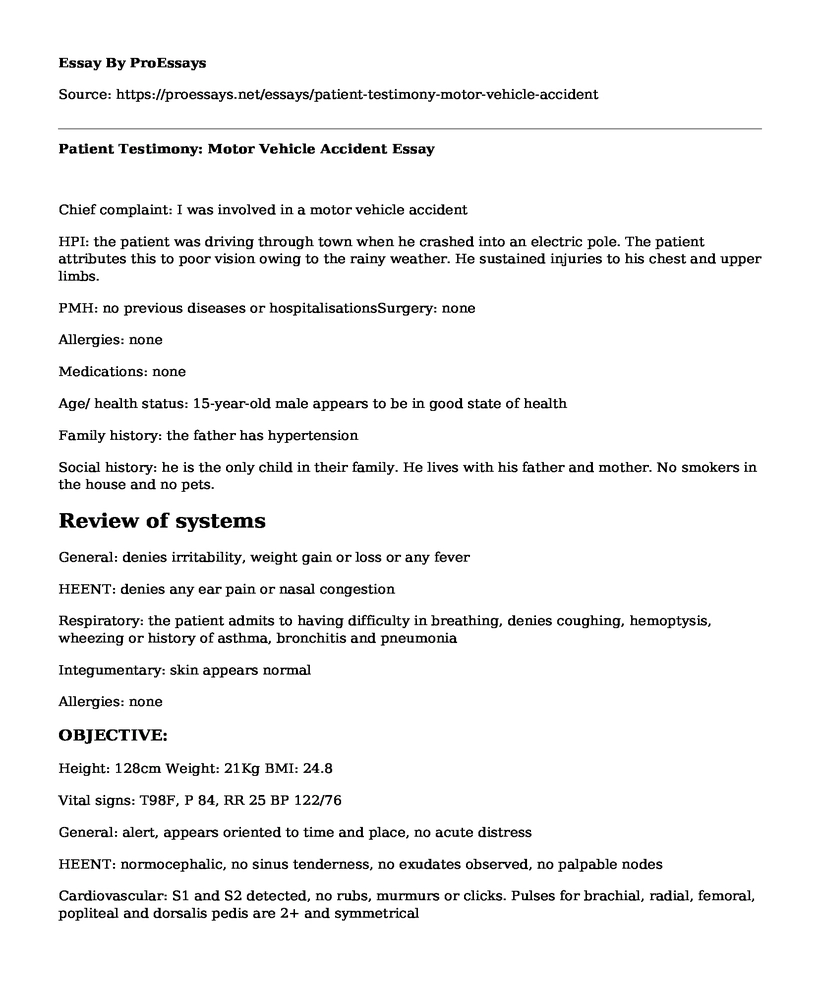Chief complaint: I was involved in a motor vehicle accident
HPI: the patient was driving through town when he crashed into an electric pole. The patient attributes this to poor vision owing to the rainy weather. He sustained injuries to his chest and upper limbs.
PMH: no previous diseases or hospitalisationsSurgery: none
Allergies: none
Medications: none
Age/ health status: 15-year-old male appears to be in good state of health
Family history: the father has hypertension
Social history: he is the only child in their family. He lives with his father and mother. No smokers in the house and no pets.
Review of systems
General: denies irritability, weight gain or loss or any fever
HEENT: denies any ear pain or nasal congestion
Respiratory: the patient admits to having difficulty in breathing, denies coughing, hemoptysis, wheezing or history of asthma, bronchitis and pneumonia
Integumentary: skin appears normal
Allergies: none
OBJECTIVE:
Height: 128cm Weight: 21Kg BMI: 24.8
Vital signs: T98F, P 84, RR 25 BP 122/76
General: alert, appears oriented to time and place, no acute distress
HEENT: normocephalic, no sinus tenderness, no exudates observed, no palpable nodes
Cardiovascular: S1 and S2 detected, no rubs, murmurs or clicks. Pulses for brachial, radial, femoral, popliteal and dorsalis pedis are 2+ and symmetrical
Respiratory: asymmetrical respiratory movements, dyspnea, lungs are not clear to auscultation, dullness detected on the left chest on percussion, no rales, rhonchi or wheezes
Integumentary; bruises on the upper limbs, no dryness, lesions, discolourations or rashes
TESTS:
Carry out a chest x-ray scan to determine the presence of fluid within the chest cavity and its location. This will also point out the location of possible fractures.
ASSESSMENT:
Paralysis of the respiratory muscles- this may be due to injury to the phrenic nerve or damage to the intercostal muscles. This leads to uncoordinated movements during respiration (Trentz, 2014).
Hemothorax- accumulation of blood in the pleural cavity (Mahoozi, Volmerig & Hecker, 2016). This space usually contains a small amount of pleural fluid. Accumulation of blood interferes with the normal respiratory movements resulting in dyspnea and poor oxygenation of blood (Aboalsaud & Deckelbaum, 2015).
PLAN:
Fix a chest tube to drain fluid that may be within the pleural space
Administer assisted ventilation
Administer morphine bolus to manage the pain
Dress bruises on the hands and arms
References
Mahoozi, H.R., Volmerig, J., & Hecker, E. (2016). Modern Management of Traumatic Hemothorax. J Trauma Treat, 5(326), 2167-1222.
Aboalsaud, A., & Deckelbaum, D.L. (2015). Chest Trauma. In Pocket Manual of General Thoracic Surgery (pp.153-174).
Springer, Cham.Trentz, O. (2014). Polytrauma: pathophysiology, priorities and management. In General Trauma Care and Related Aspects (pp. 69-76). Springer, Berlin, Heidelberg.
Cite this page
Patient Testimony: Motor Vehicle Accident. (2022, May 09). Retrieved from https://proessays.net/essays/patient-testimony-motor-vehicle-accident
If you are the original author of this essay and no longer wish to have it published on the ProEssays website, please click below to request its removal:
- Course Work Example: Social Work with Volunteer Family
- Sociology of Health as My Field of Interest Paper Example
- Paper Example on 1 Million Americans Are Affected by Sepsis Annually
- Essay Example on Random Factor Linked to Cancer: An Unending Burden
- Essay on Parents Apprehended for Refusing Hospital: Madeline Neumann's Tragic Story
- U.S. Pharmaceutical Prices: Local vs. Foreign Sources of Drugs - Essay Sample
- Essay Sample on Diagnosing Mental Disorders: 2 Case Studies







